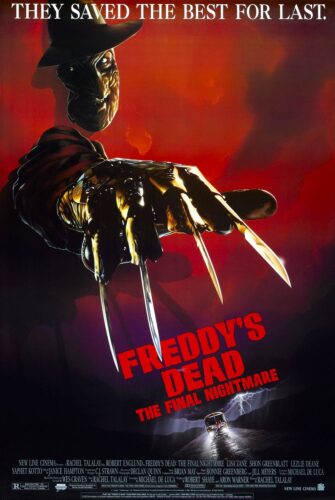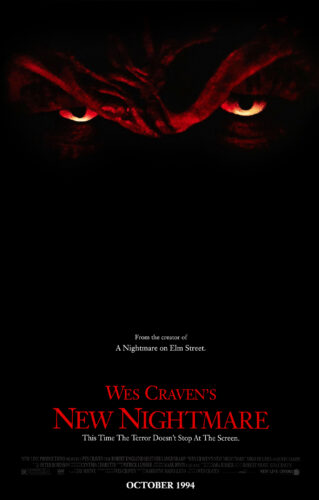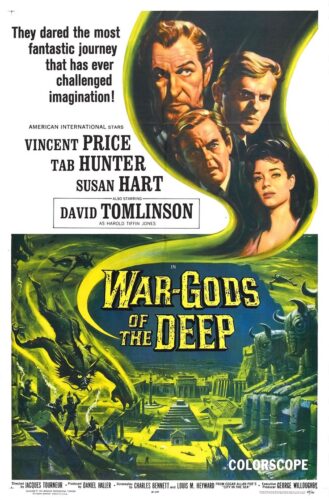 Freddy’s Dead: The Final Nightmare (1991) – If Elm Street 5 was the last attempt to photocopy Elm Street 3, Freddy’s Dead is full-scale bad fanfic put on screen. In a full break from any other character we’ve seen (except Freddy himself, of course), we begin with an amnesiac teenager — the last child in Springwood (which is now established as being in Ohio) — trying to escape, with Freddy trying to prevent him through various dream schemes that are more like Looney Tunes than anything we’ve seen in previous Elm Street dream sequences. Then the kid goes back to Springwood (and it’s established now that Freddy’s isn’t confined to the children of his vigilante executioners, but to the town itself), but this time it’s with a therapist and a few other kids from the facility he’s been thrown in. And Freddy does some really stupid stuff, like playing one kid like a videogame character. And then we change protagonists entirely. And also Yaphet Kotto shows up as (in Spike Lee’s phrase) the “super-duper magical Negro,” who’s with-it enough to figure out how to fight Freddy in dreams… using exactly the same “pull him out of the dream” scheme that was the climax of the first Elm Street. Except this time, the dream sequence is in 3-D! (At least for those unfortunate few who saw this in the theater.) I almost think that this installment was deliberately intended to be a horror-comedy, with the oversight being that they forgot to make it funny, either.
Freddy’s Dead: The Final Nightmare (1991) – If Elm Street 5 was the last attempt to photocopy Elm Street 3, Freddy’s Dead is full-scale bad fanfic put on screen. In a full break from any other character we’ve seen (except Freddy himself, of course), we begin with an amnesiac teenager — the last child in Springwood (which is now established as being in Ohio) — trying to escape, with Freddy trying to prevent him through various dream schemes that are more like Looney Tunes than anything we’ve seen in previous Elm Street dream sequences. Then the kid goes back to Springwood (and it’s established now that Freddy’s isn’t confined to the children of his vigilante executioners, but to the town itself), but this time it’s with a therapist and a few other kids from the facility he’s been thrown in. And Freddy does some really stupid stuff, like playing one kid like a videogame character. And then we change protagonists entirely. And also Yaphet Kotto shows up as (in Spike Lee’s phrase) the “super-duper magical Negro,” who’s with-it enough to figure out how to fight Freddy in dreams… using exactly the same “pull him out of the dream” scheme that was the climax of the first Elm Street. Except this time, the dream sequence is in 3-D! (At least for those unfortunate few who saw this in the theater.) I almost think that this installment was deliberately intended to be a horror-comedy, with the oversight being that they forgot to make it funny, either.
Freddy’s makeup here continues the trend of becoming smoother and less scary, and the sweater is so spotless it must have just come back from the cleaner’s. It’s friendly Uncle Freddy, scoring the fewest kills ever, in an outing that’s roughly as horrifying as a Miss Marple mystery.
Giving credit where credit is due, the flashbacks to a pre-deceased Freddy (Robert Englund without makeup!) are not terribly done, and the idea that Freddy had an actual motive for his rampage (he was still already a thrill-killer, but he became a devoted child murderer for a reason) might have worked in an earlier installment, written and directed competently (and edited — it felt like whole scenes were excised at random, although I’m definitely not complaining that it was too short). But for something that wanted to be the wrapping-up of the whole franchise, this was just an embarrassment.
(The other noteworthy moment is the hilarious mugging Englund does before he kills the hearing-impaired boy by scratching his claws on a chalkboard. Englund should have been in more straight-up comedies.)
 Wes Craven’s New Nightmare (1994) – In contrast to the heaping pile of incompetence that was the “final” Elm Street movie, Wes Craven’s attempt to revisit and resignify the whole franchise, along with commentary on Hollywood’s influence on culture and the confusion of actor and character, is a noble failure. Definitely, a failure, though. The concept behind it is fascinating — that an evil entity could inadvertently be trapped in a story which truly “captured” its essence — but it was just beyond Craven’s power to pull it off.
Wes Craven’s New Nightmare (1994) – In contrast to the heaping pile of incompetence that was the “final” Elm Street movie, Wes Craven’s attempt to revisit and resignify the whole franchise, along with commentary on Hollywood’s influence on culture and the confusion of actor and character, is a noble failure. Definitely, a failure, though. The concept behind it is fascinating — that an evil entity could inadvertently be trapped in a story which truly “captured” its essence — but it was just beyond Craven’s power to pull it off.
A huge part of the problem is having the entire movie hinge on the performance of a child actor — and not just any child actor, but Miko Hughes, otherwise best known as the “Boys have a penis, girls have a vagina” kid from Kindergarten Cop. He’s competent and all, but he’s just too cute to be taken seriously when he growls at the people around him and tries to slash them with steak knives taped to his fingers. (Compare him to Whitby Hertford, who played the as-yet-unborn Jacob in Elm Street 5 — say what you will about the movie, that kid could look spooky.)
 War-Gods of the Deep (1965) – Coming at the tail end of American International’s string of Edgar Allan Poe adaptations, this putative adaptation of Poe’s “City in the Sea” comes across as a last gasp of a tired production ethos, with set pieces thrown together almost at random. Tab Hunter is an American in Cornwall for no reason except to give us an American hero (and Susan Hart is the equally misplaced American love interest); David Tomlinson of Mary Poppins fame is the chicken-obsessed artist providing much-needed comic relief. And Vincent Price is the iron-fisted nobleman-turned-smuggler who’s been hiding in underwater caverns for a century with his crew, caverns once hollowed out by a long-lost Atlantean race, of whom the last surviving members are the stuntmen we see with baggy gill-man costumes over their wetsuits.
War-Gods of the Deep (1965) – Coming at the tail end of American International’s string of Edgar Allan Poe adaptations, this putative adaptation of Poe’s “City in the Sea” comes across as a last gasp of a tired production ethos, with set pieces thrown together almost at random. Tab Hunter is an American in Cornwall for no reason except to give us an American hero (and Susan Hart is the equally misplaced American love interest); David Tomlinson of Mary Poppins fame is the chicken-obsessed artist providing much-needed comic relief. And Vincent Price is the iron-fisted nobleman-turned-smuggler who’s been hiding in underwater caverns for a century with his crew, caverns once hollowed out by a long-lost Atlantean race, of whom the last surviving members are the stuntmen we see with baggy gill-man costumes over their wetsuits.
Oh, and there’s an undersea volcano. Off the coast of Cornwall. Because sure why the hell not.
While I never have begrudged Vincent Price a paycheck, I watched this whole movie waiting for it to get good. I’m still waiting.